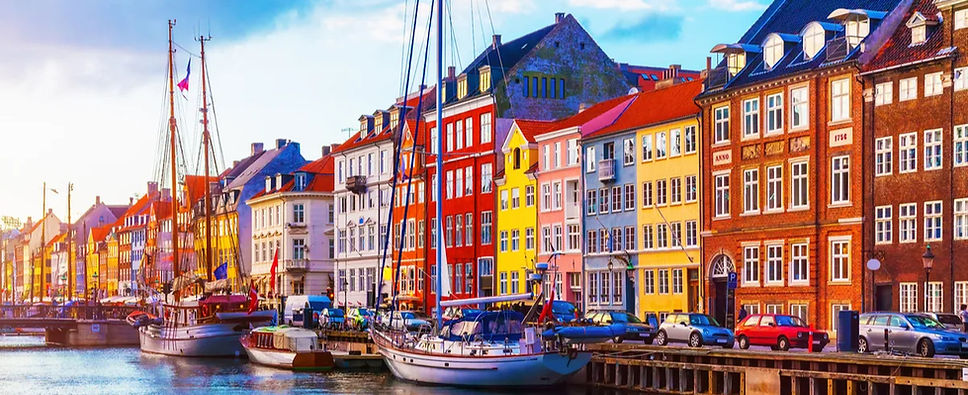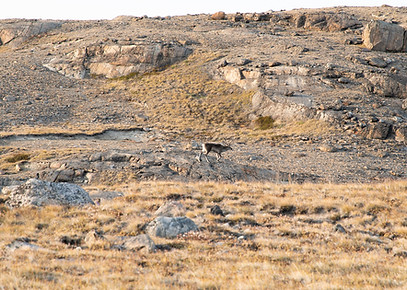
Greenland Itinerary - 8 days, 7 nights
September 5-12, 2026
September 12- 19, 2026

Copenhagen, Denmark
Day 1
Kangerlussuaq, Greenland - Embarkation
On the first day of our expedition, we board our flight* from Copenhagen bound for Kangerlussuaq on the west coast of Greenland.
Situated at the head of a 160km long fjord of the same name, Kangerlussuaq is Greenland's only inland town, and was established as Søndrestrom Air Base/Bluie West-8 by American troops in 1941. Existing largely to service the airport, the town of Kangerlussuaq itself retains a strong 'Cold War' feeling, hinting at its extensive American military use before it was signed over to the Greenlandic Government in 1992. Today Kangerlussuaq is Greenland's largest air hub, with flights arriving daily from Denmark and around the country. It's stable climate and lack of fog makes it ideal as an airport, but it exhibits some of the most varied temperatures in the country, commonly registering the highest summer and lowest winter temperatures due to its inland location.
Upon arrival in Kangerlussuaq, you will be transported to the small port located west of the airport, where the Ocean Albatros awaits at anchor. Zodiacs will transfer us the short distance to the ship, where you will be checked in to your stateroom. After the mandatory safety drill, enjoy dinner and a glass of champagne as we set sail a course for adventure through the 160-kilometre Kangerlussuaq fjord.
*If you would like to arrive via local flight from Nuuk. You will need to make arrangements to be transferred to the port to board the Zodiacs.
Day 2
Sisimiut - Greenland's Second City
Sisimiut is Greenland’s second-largest city, with around 5,400 residents. Inhabited since 2,500 BC by Paleo-Inuit peoples, the area holds ancient remains on nearby Tele Island, which can be reached on a refreshing hike. Founded as Holsteinsborg in 1756, Sisimiut features well-preserved historic buildings like the Blue Church from 1775, situated in the city’s charming museum quarter.
Today, Sisimiut is a key hub for education and industry, hosting one of Greenland’s largest fish processing plants and the supply company KNI, which services remote settlements. The city blends traditional and modern Arctic life—explore the cultural center Taseralik, the city museum, and the famous art workshop, and taste Greenlandic delicacies.

Day 3:
Qeqertarsuaq, Disko Island
Qeqertarsuaq is a picturesque town nestled beneath Disko Island’s towering basalt mountains. Once the heart of North Greenland’s whaling economy, the town shifted focus to hunting, fishing, and growing tourism after the industry declined. Qeqertarsuaq’s rich volcanic soil and mild microclimate create uncommonly lush greenery, attracting locals and visitors to its rugged beauty, colorful houses and excellent hiking. In the afternoon, we’ll explore the dramatic coastline of nearby Kuannit by Zodiac, famed for lush tundra, caves, waterfalls, and stunning icebergs, before heading north towards Uummannaq.
Day 4:
Uummannaq - the Greenlandic Riviera
Uummannaq sits at the foot of its striking 1,170m “heart-shaped” mountain – a true Greenlandic landmark. Founded in 1763 by Danish colonists, the town blends historic charm with rich Inuit heritage. Today, Uummannaq is a lively community where locals sell traditional handicrafts in the town square and fresh fish at the bustling market, and locals are strongly connected to their traditional lifestyle. Visit the museum for an insight into local history, or hike to Santa’s house – another famous local landmark. As we sail into Uummannaq Fjord, take in breathtaking views of the iceberg-studded waters and towering peaks beneath the endless midnight sun.
Day 5:
Eqip Sermia Glacier
From Uummannaq, we return to the heart of Disko Bay, setting sail towards Eqip Sermia.
Eqip Sermia (a typically descriptive Greenlandic name meaning 'the Glacier at the End of the Fjord') is a relatively small glacier compared to many in Greenland, although it is still a truly vast river of ice, flowing directly from the Greenland Ice Sheet. It is also one of the most active, and ice tumbles off the vast glacier-front almost constantly. Watching the vast cataracts of ice fall into the ocean is a sight which has to be seen to be believed, and the comfortable viewing decks of Ocean Albatros offer the best possible platform to do so... Perhaps with a specially crafted cocktail in hand!
If conditions allow, we will launch our fleet of Zodiacs to approach this vast river of ice, and hopefully experience the roar of the glacier's frequent calvings at sea level (from a safe distance of course)!
From Eqip Sermia, we will reposition slightly southwards during the evening towards Ilulissat, the largest city in Disko Bay and the Iceberg Capital of the World.

Day 6
Ilulissat - Iceberg capital of the world
This is it. This is why visitors from all over the world come to Greenland. Translated from Kalaallisut simply as ‘icebergs’, Ilulissat is rightly known the world over as ‘the Iceberg Capital of the World’. Surely no other city on Earth occupies such a spectacular natural setting.
Situated within a short walk of the harbour lies Ilulissat Icefjord, Greenland’s most famous site. Choked with city-sized icebergs so closely packed one could almost walk across to the other side, Ilulissat Icefjord stretches 70 km from its outlet in Disko Bay near the city of Ilulissat back to the Sermeq Kujalleq glacier. This is the single largest glacier on Earth outside Antarctica, draining 13% of the Greenland Ice Sheet, and producing 10% of all the ice in the Northern Hemisphere (enough water to supply the annual needs of the entire United States). These mind-blowing statistics, together with the indescribably beautiful scenery, have secured the Ilulissat Icefjord designation as a UNESCO World Heritage Site.
While archaeological finds detail the long Inuit habitation of the area, the modern town has steadily flourished in the 280 years since its establishment; legendary Arctic explorer, Knud Rasmussen was born in Ilulissat, and his childhood home now houses the city museum. Today, Ilulissat is Greenland’s third largest town, with more than 4,500 inhabitants, and is undoubtedly Greenland’s tourism capital, with more hotel rooms than even Nuuk. The city offers excellent amenities to visitors, with fresh locally caught seafood served in the city’s cafes and restaurants, and excellent shopping – look out especially for the Artist’s Workshop above the harbour, where you can buy handmade artworks direct from the artist. The city typically experiences dry sunny weather throughout the summer, and there are a variety of well-marked hiking routes around the Icefjord, with options to suit all abilities.
During the visit you will have the opportunity to join a boat trip with a local captain to the Icefjord (optional excursion – charge applies). The journey takes about two and a half hours and is considered the best way to experience the magic of Ilulissat Icefjord up close. If a hike or a trip by boat does not present enough excitement, there is also the opportunity to join a flightseeing excursion in fixed-wing aircraft over the Icefjord (optional excursion – charge applies).
Please note the boat and flight excursions to the Icefjord are not included in the general tour price.
Day 7
The settlement of Itilleq
The settlement of Itilleq, which translates roughly as "the Crossing Place from the Sea” nestles at the foothills of the mountains and and fjords which line central Greenland's backcountry. Situated just north of the Arctic Circle, Itilleq is one of the many tiny villages dotting the coast of Greenland. The settlement is situated in the heart of the Aassivisuit-Nipisat UNESCO World Heritage Site, which was inscribed due to its ancient Inuit hunting heritage, documenting the entire habitation history of Greenland.
While the turf houses and hide tents have been replaced by colourful modern houses, the lifestyle here has changes little since the Inuit first arrived in Greenland. The local highways are the water and the ice, and the sea and tundra continue to nourish the locals, as they has for thousands of years. Arctic char, reindeer and muskoxen are typical catches, and are all plentiful in the area.
Despite this ancient heritage, locals in Itilleq are still firmly in the modern world, with smartphones, speedy wifi and satellite TV. However, the people of Itilleq remain justly proud of their ancient heritage, and continue to move their culture forward in a modern fast paced world. Locals are pleased to show off their piucturesque town, and visitors are greeted with typical warm Greenlandic hospitality.
After departing Itilleq, we will head slightly south and enter the 160km-long Kangerlussuaq Fjord.




Day 8:
Kangerlussuaq, Greenland - Disembarkation
During the night, we will sail up the 160-kilometer/100 mile Kangerlussuaq Fjord. After breakfast aboard the ship, we will bid a fond farewell to the ship's crew, Expedition Team and fellow travellers before shuttling ashore by Zodiac.
Due to Kangerlussuaq’s military history and present-day role as an important air travel hub, Kangerlussuaq remains fairly isolated from Greenland’s rich cultural traditions, in comparison to other regions. While you still find cultural experiences when visiting Kangerlussuaq, the most impressive attraction is the surrounding nature, which is just beckoning to be explored. The town itself was largely constructed by the American military in the 1950s, and this small airport town has retained something of its Cold War atmosphere. Your Arctic adventure and time in Greenland concludes as we board the flight from Kangerlussuaq back to the southern world.